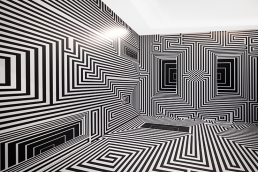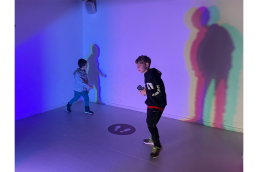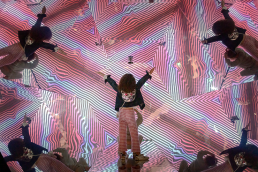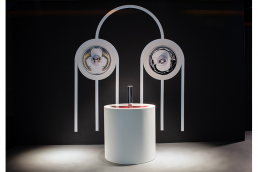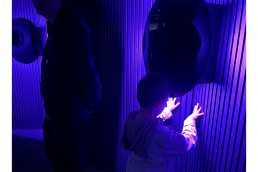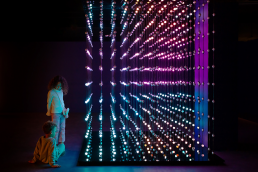This website uses cookies so that we can provide you with the best user experience possible. Cookie information is stored in your browser and performs functions such as recognising you when you return to our website and helping our team to understand which sections of the website you find most interesting and useful.
Twist Museum
ProjectTwist MuseumLocationLondon, UKArchitectMDM CreateInstallerCrossoverSubmitted byPixelbeach
Twist Museum which stands for “The Way I See Things” merges technology with the work of artists, psychologists, and neuroscientists from around the world. TWIST Museum, situated on London’s Oxford Street, has added a new avenue of exploration to one of the busiest high streets in Europe.
Launched in November 2022, the mission-critical audiovisual environments at TWIST were specified, installed, programmed and commissioned by Crossover and led by our Senior Systems Designer Juan Garcia, and Project Manager Ben Manning.
The team worked closely with the museum directors, technical consultants Artists & Engineers, creative design house MDM Create, and a host of hand-picked international artists to deliver an eye-catching 15,000 sq ft visitor attraction in the heart of London’s West End that appeals to and entertains both children and adults across the whole spectrum. Since opening it has been a huge commercial success, regularly selling out.
The museum should win this award because it has found a way to use technology to make a unique and innovative visitor attraction that is accessible on all levels; its use of colour and technology has made it appeal to the TikTok and Instagram generation.
Kids are nagging parents to take them to this “cool” place so they can mimic the images they see on social media, but while they are there, they are experiencing art and science in forms they may never have seen before. Twist has merged education, art and fun, and created a “social media buzz” that many traditional museums and art galleries have been unable to achieve.
This museum is bringing a generation to its doors who have potentially avoided museums and art galleries in favour of watching the world through a small screen, and that can only be seen as a huge positive.
As one person states on Tripadvisor “Great fun for all ages and my autistic adult son really enjoyed it. As an art teacher, I can see how young people could benefit from it educationally as it’s accessible on all levels and it’s a good introduction to colour theory and op art. It’s very playful and interactive. Good for getting some interesting photos hence there are lots of TikTokers, which is how I knew about the exhibition.”
Within the Twist Museum, there are many different exhibits that utilise both audio and visual technology; one of the main audio-heavy exhibits is an acoustically treated Audio Interactive Space, where the visitors are surrounded by eight individually controlled Genelec 4430AM loudspeakers.
This 360° surround sound room features soundscapes created by artist and composter Antoine Bertin, while custom-programmed LED lighting is synchronised with the audio to enhance the sensory impact. Our design team chose the Genelec POE speakers for their dispersion pattern and audio quality.
The Martin Audio SX110 sub-installed in the ceiling subtly enhances the bass. The sound dances nimbly around visitors within the space and, when combined with lighting effects synced to the audio content, the effect is truly mesmerising. This exhibit also has the opportunity to evolve in months and years with different artists having the scope to do all sorts of things in the space.
Towards the end of the journey, visitors enter the Upside-Down Room, which features a Martin Audio system that was chosen so the venue could hire out the space for events and parties. In this space, Crossover installed four Martin Audio ADORN A55T speakers and an SX110 sub, which are powered by a Martin Audio VIA2004 amp. These were chosen because they offer great-quality audio for a midground system.
The Digital Mirror, which distorts peoples’ reflections in real time was developed by multimedia artist Aristotle Roufanis. This piece uses a Z CAM E2-M4 4K Cinema Camera, which feeds the images into a PC in the rack room where customised software manipulates the image and then replays it back to a screen in front of the person in almost real-time. The screen used is a 65-inch LG UHF5-H, while the speakers set up across most of the open areas of the museum to provide background ambience are Biamp MASK6CT 6.5-inch.
The Digital Kaleidoscope is a mirrored hexagonal tube where people who enter are immersed in a vibrant display of colours, patterns, and their digital ‘reflection’ – all of which is influenced by their movements and interactions while inside the tube.
Another feature includes an Azure Kinect camera, which captures a person’s movement inside, and as they move the image is distorted using the same software as at the Digital Mirror. An Optoma ZU500USTe projector back-projects the manipulated movements onto a custom hexagonal screen from Screen International.
The Mind Hub has a large cube with 1,000 individually-controlled LED spheres hanging from the ceiling which, as they change colour, create oscillating patterns and shapes. This fixture was bespoke, as the LED structure was put together specifically for this site. It is a 10 by 10 by 10 matrix, and each RGB LED is addressable.
Madrix Nebula SPI Controllers are installed above the fixture, driving the data to each LED, while the software that is running this exhibit is the same as the Digital Mirror and Digital Kaleidoscope, which is customised using node-based visual programming language, called TouchDesigner.
The Ames room; a concept originally pioneered by Adelbert Ames Jr, gives the illusion of people appearing smaller or larger, depending on their location within the space. A Sony SRG-X120 PTZ camera and Sony 55in FW-55BZ40H allow visitors in the room to experience the shrinking effect as if they were viewing it from outside.
The overarching control of the venue’s audio, video and lighting is via Q-SYS, which gives museum staff complete and easy control utilising a simple touch-panel interface.
One of the main obstacles we encountered was that the size and content of some exhibits were changing while we were installing them. This necessitated a high degree of flexibility and adaptability from our team, as we had to adjust our plans, scope, and technical approaches on the go.
This added an extra layer of complexity to an already complicated project. However, thanks to the dedication and hard work of our project management team and designers, we were able to overcome these obstacles and achieve a successful grand opening, delivering the project on time and on budget.
